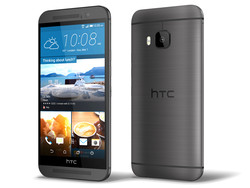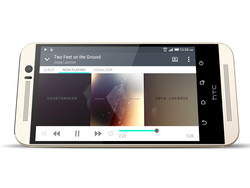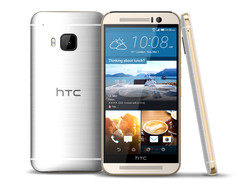HTC One M9 First Impressions

For the original German article, see here.
Prior to the publishing of our comprehensive review of the HTC One M9, we want to outline our first impressions for our readers and provide you with our first test results. The One M9's predecessor from the previous year, the One M8, made a good impression on us and only received criticism for its mediocre camera. HTC wants to turn that around and sent their new smartphone into the running with a new 20 MP camera module. The speedy Qualcomm Snapdragon 810 ought to provide the necessary computing power for lightning-fast performance, and the somewhat larger battery promises good stamina as well.
The HTC One M9 has many competitors, but we have to compare it to the previous year's models. Both the LG G3 and the Samsung Galaxy S5 already have successors behind the starting gate. The Xperia Z3 and the OnePlus One represent the remaining Android competitors in this class. The iPhone 6 and the Lumia 930 are based on iOS and Windows Phone, respectively.
First Impression
On the outside, the HTC One M9 hardly differs from its predecessor. The case is still constructed of brushed aluminum and not only looks attractive but is pleasing to the touch. It also feels very good in your hand. For the first time, the metal is available in two colors; a world premiere, according to the Taiwanese manufacturer.
The smartphone's speakers are still impressive and some of the best we've seen in a mobile phone. HTC even one-upped themselves and are promising virtual surround sound. They've also made a few small updates in the realm of communications modules: Bluetooth is now available in version 4.1 and LTE in Cat. 6. The Snapdragon 810 would also have been able to support LTE Cat. 9.
With an update, HTC now has the previously known problem with surface temperatures well under control. We will discuss this at length in our forthcoming comprehensive review.
Cameras
The One M8's ultra-pixel lens has now migrated to the front side of the smartphone, while the backside is now outfitted with an unsparing 20 MP camera. Compared to the M8 (4 MP), this is a huge improvement. Our comprehensive review will reveal whether HTC has finally managed to provide a first-class camera.
The back camera's specs are extremely promising. The f/2.2 aperture promises good light sensitivity, and all the important functions like autofocus and HDR are on board. Videos can be recorded in Ultra HD.
Display
The display remains unchanged: 5-inches with a resolution of 1920x1080 pixels. The resulting pixel density of 441 PPI makes the screen content look razor sharp.
With the display's improved black value, HTC was able to boost the contrast ratio yet again. Unfortunately, the brightness distribution is now mediocre, and the color-space coverage leaves something to be desired. The panel shows some substantial deviations in the realm of color accuracy, and the grayscale is plagued by an especially visible blue cast.
| |||||||||||||||||||||||||
Brightness Distribution: 85 %
Center on Battery: 474 cd/m²
Contrast: 1185:1 (Black: 0.4 cd/m²)
ΔE ColorChecker Calman: 6.32 | ∀{0.5-29.43 Ø4.77}
ΔE Greyscale Calman: 6.36 | ∀{0.09-98 Ø5}
58.81% AdobeRGB 1998 (Argyll 1.6.3 3D)
Gamma: 2.43
CCT: 8218 K
| HTC One M9 Adreno 430, 810 MSM8994, 32 GB eMMC Flash | HTC One M8 Adreno 330, 801 MSM8974AB, 16 GB iNAND Flash | Sony Xperia Z3 Adreno 330, 801 MSM8974AC, 16 GB eMMC Flash | Apple iPhone 6 PowerVR GX6450, A8, 128 GB eMMC Flash | Samsung Galaxy S5 Adreno 330, 801 MSM8974AC, 16 GB eMMC Flash | OnePlus One Adreno 330, 801 MSM8974AC, 64 GB eMMC Flash | |
|---|---|---|---|---|---|---|
| Screen | -3% | -13% | 2% | -1% | -14% | |
| Brightness middle (cd/m²) | 474 | 474 0% | 702 48% | 520 10% | 358 -24% | 423 -11% |
| Brightness (cd/m²) | 458 | 486 6% | 671 47% | 511 12% | 364 -21% | 408 -11% |
| Brightness Distribution (%) | 85 | 93 9% | 90 6% | 88 4% | 82 -4% | 83 -2% |
| Black Level * (cd/m²) | 0.4 | 0.54 -35% | 0.72 -80% | 0.61 -53% | 0.54 -35% | |
| Contrast (:1) | 1185 | 878 -26% | 975 -18% | 852 -28% | 783 -34% | |
| Colorchecker dE 2000 * | 6.32 | 5.86 7% | 8.92 -41% | 3.92 38% | 5.28 16% | 5.56 12% |
| Greyscale dE 2000 * | 6.36 | 5.2 18% | 9.59 -51% | 4.33 32% | 4.65 27% | 7.55 -19% |
| Gamma | 2.43 91% | 2.29 96% | 2.75 80% | 2.46 89% | 2.48 89% | 2.33 94% |
| CCT | 8218 79% | 7218 90% | 9408 69% | 7384 88% | 7690 85% | 7624 85% |
| Color Space (Percent of AdobeRGB 1998) (%) | 58.81 |
* ... smaller is better
Performance
The Snapdragon 810 MSM8994 in the HTC One M9 is responsible for the smartphone's powerful system performance. The SoC is the current crème-de-la-crème from the Californian manufacturer and one of the fastest chips on the market. Only the Tegra K1 and Samsung's Exynos 7420 can compete with this potent processor. The chip computes on eight CPU cores in total (4x Cortex-A57, 4x Cortex-A53) and clocks at up to 2.0 GHz. 64-bit computing is also supported. The Google Android 5.0.2 Lollipop OS can fully utilize the SoC's resources. The processor is supported by 3 GB of RAM. The integrated Adreno 430 takes care of graphics tasks and should be up to 30% faster than its predecessor (the Adreno 420).
In the benchmarks, the HTC One M9 produced very good results, though we honestly would have expected a little more. Apple's A8 SoC is sometimes a bit faster, as is Nvidia's Tegra K1. Even the Snapdragon 805, our current model's predecessor, sometimes achieves better results. We'll take a closer look at the reasons for this behavior in our comprehensive review.
| AnTuTu v5 - Total Score (sort by value) | |
| HTC One M9 | |
| Apple iPhone 6 | |
| NVIDIA Shield Tablet P1761W | |
| Google Nexus 9 | |
| Google Nexus 6 | |
| Samsung Galaxy Note 4 | |
| OnePlus One | |
| 3DMark | |
| 1280x720 offscreen Ice Storm Unlimited Score (sort by value) | |
| HTC One M9 | |
| Apple iPhone 6 | |
| NVIDIA Shield Tablet P1761W | |
| Google Nexus 9 | |
| Google Nexus 6 | |
| Samsung Galaxy Note 4 | |
| OnePlus One | |
| HTC One M8 | |
| 1280x720 offscreen Ice Storm Unlimited Graphics Score (sort by value) | |
| HTC One M9 | |
| Apple iPhone 6 | |
| NVIDIA Shield Tablet P1761W | |
| Google Nexus 9 | |
| Google Nexus 6 | |
| Samsung Galaxy Note 4 | |
| OnePlus One | |
| HTC One M8 | |
| 1280x720 offscreen Ice Storm Unlimited Physics (sort by value) | |
| HTC One M9 | |
| Apple iPhone 6 | |
| NVIDIA Shield Tablet P1761W | |
| Google Nexus 9 | |
| Google Nexus 6 | |
| Samsung Galaxy Note 4 | |
| OnePlus One | |
| HTC One M8 | |
| GFXBench 3.0 | |
| on screen Manhattan Onscreen OGL (sort by value) | |
| HTC One M9 | |
| Apple iPhone 6 | |
| NVIDIA Shield Tablet P1761W | |
| Google Nexus 9 | |
| Google Nexus 6 | |
| Samsung Galaxy Note 4 | |
| OnePlus One | |
| HTC One M8 | |
| 1920x1080 1080p Manhattan Offscreen (sort by value) | |
| HTC One M9 | |
| Apple iPhone 6 | |
| NVIDIA Shield Tablet P1761W | |
| Google Nexus 9 | |
| Google Nexus 6 | |
| Samsung Galaxy Note 4 | |
| OnePlus One | |
| HTC One M8 | |
| Browsermark - 2.1 (sort by value) | |
| HTC One M9 | |
| Apple iPhone 6 | |
| Samsung Galaxy Note 4 | |
| OnePlus One | |
| Nokia Lumia 930 | |
| Octane V2 - Total Score (sort by value) | |
| HTC One M9 | |
| Apple iPhone 6 | |
| NVIDIA Shield Tablet P1761W | |
| Google Nexus 9 | |
| Google Nexus 6 | |
| Samsung Galaxy Note 4 | |
| Nokia Lumia 930 | |
| HTC One M8 | |
| Mozilla Kraken 1.1 - Total (sort by value) | |
| HTC One M9 | |
| Apple iPhone 6 | |
| NVIDIA Shield Tablet P1761W | |
| Google Nexus 9 | |
| Google Nexus 6 | |
| Samsung Galaxy Note 4 | |
| OnePlus One | |
| Nokia Lumia 930 | |
| HTC One M8 | |
* ... smaller is better
(+) The maximum temperature on the upper side is 38.4 °C / 101 F, compared to the average of 35.2 °C / 95 F, ranging from 21.9 to 247 °C for the class Smartphone.
(+) The bottom heats up to a maximum of 36.1 °C / 97 F, compared to the average of 34 °C / 93 F
(+) In idle usage, the average temperature for the upper side is 30.8 °C / 87 F, compared to the device average of 32.9 °C / 91 F.
Energy & Battery Life
The HTC One M9's power consumption in standby and when shut off is exemplary. In idle mode, however, the smartphone's energy usage is quite high. The Samsung Galaxy S5 (0.3-1.1 W) achieves substantially superior results. Despite the One M9's high performance, its power consumption proves to be rather low under load, though given these results the smartphone isn't going to break any records in our battery tests. The One M9 neither supports Fast Charge nor wireless charging.
| Off / Standby | |
| Idle | |
| Load |
|
Key:
min: | |
Verdict
Unfortunately, the HTC One M9 doesn't have anything truly revolutionary to offer, but it's clear that the manufacturer tried to maintain the smartphone's tried-and-true features, while making improvements where the predecessor received criticism.
The look and feel of the One M9 are top-notch and certainly meet the requirements for a premium product. The new camera will need to prove itself, and we're also intrigued to see whether HTC truly got a handle on the Snapdragon processor's legendary problems with overheating.
The most suspenseful question, however, is whether HTC can justify raising the recommended retail price by 50 Euros (~$54). The market price is sure to fall quickly, but users may be left with a bad taste in their mouths. Our comprehensive review is soon to follow.











